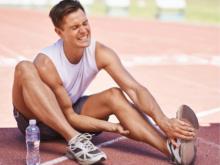
Some people call them muscle spasms, some refer to them as a charley horse, but a muscle cramp by any name is still painful. They can occur in the middle of the night, during a tennis match or following a long run. You don’t have to be a dedicated athlete to have a muscle cramp; it’s a “pleasure” we all get to experience. Although vigorous exercise can frequently bring on this problem, there are several other factors known to contribute.
Why Muscles Cramp
When a muscle contracts during use, it actually shortens, and at the same time undergoes a change in the potassium and sodium content (electrolytes) within the fibers. When the muscle relaxes, these chemicals go back to their normal state of balance. It’s when the muscle has been worked long and hard enough to maintain an imbalance of these electrolytes that the muscle will contract involuntarily.
Dehydration from inadequate fluid intake or excessive sweating can also affect the levels of potassium and sodium, thereby triggering a cramp. Less common causes include calcium deficiency, diseases affecting the nervous system and disorders associated with aging.
Acupressure Can Help
There are two acupressure methods used to relieve a cramped calf muscle.
1. Apply pressure to associated trigger points.
Apply pressure to either of these two antispasmotic points as soon as you feel the cramp. Maintain the pressure until the cramp resolves.
• A – Between the lip and the nose, two-thirds of the way up. Press your index finger or a knuckle into the site while you breathe deeply (see Figure 1).
• B – On top of the foot, at the hollow indentation between the big toe and second toe. Press your index and middle fingers into the site, angling toward the bone of the second toe.
2. Apply pressure to site of the cramp.
Press thumbs gently into the site of the cramp, at the center of the calf muscle, maintaining pressure for 2–3 minutes. As this is a sensitive site, apply pressure gradually. This counteracts the spasm and will eventually bring the muscle back to a relaxed state. Once the muscle has relaxed, continue gentle pressure at this site while you also press on the site on top of the foot. This will bring balance to the cramp area.
Stretch and Massage
Instinct usually directs us to grab the calf and start rubbing when a muscle cramp starts, although it helps if you first stretch the muscle by straightening the leg and pulling the toes directly toward you. This increases circulation as it lengthens the contracted muscle. Follow this with gentle rubbing of the cramp site.
To ward off future attacks, practice daily self-massage of the calf. Sit on the floor with the knee bent and lower leg at a 45-degree angle. Using your thumbs and fingers, combine cross-fiber strokes with effluerage to massage the calf muscles.
Prevent Muscle Cramps
The following will help stave off cramps before they begin:
• Drink plenty of water, especially when engaging in physical activities.
• Eat foods high in potassium, such as bananas.
• Make sure you’re getting enough calcium in your diet.
• Use stretching exercises appropriate to your sport.
• Stop exercising before your muscles become over-fatigued.
• If you are prone to cramping, regularly massage your calf area.




